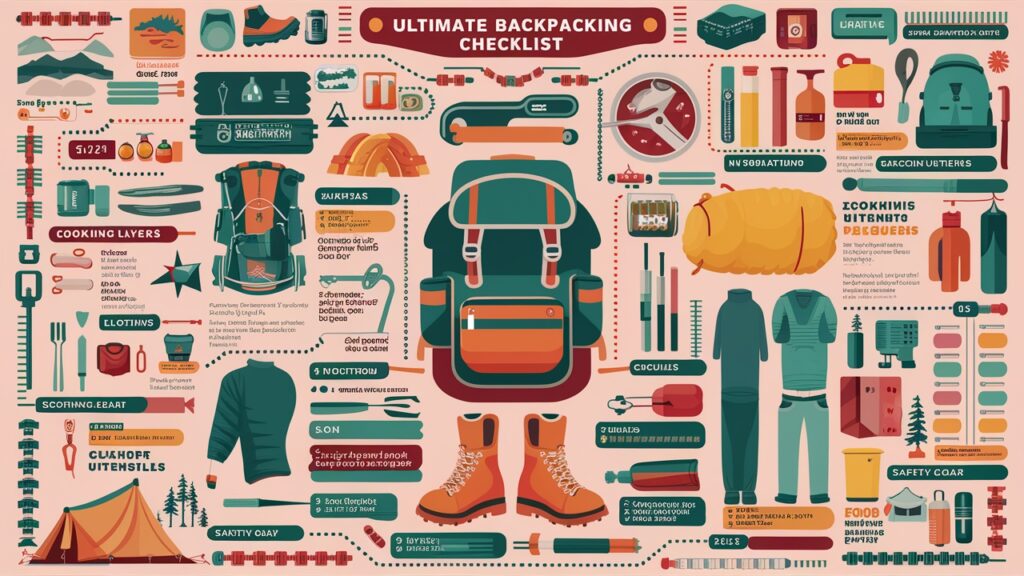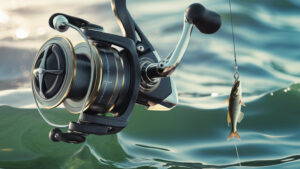An ultimate backpacking checklist includes essential gear, clothing, food, and safety items. Organizing your items ensures a successful and enjoyable trip.
Preparing for a backpacking adventure requires careful planning and the right gear. An ultimate checklist helps you avoid forgetting crucial items. From tents and sleeping bags to first aid kits and cooking supplies, each element plays a vital role in your journey.
Proper organization leads to a lighter pack and a more enjoyable experience on the trail. Whether you’re a novice or a seasoned hiker, having a comprehensive checklist simplifies your packing process. This guide will cover everything you need to ensure you’re ready for your next outdoor expedition. Embrace the thrill of nature with confidence and the right preparation.
Introduction To Backpacking Essentials
Backpacking offers adventure and freedom. Planning is key to enjoy this experience. The right gear makes every trek safer and more enjoyable. This guide provides a comprehensive checklist for your next trip.
Why The Right Gear Matters
Choosing the right gear is crucial. It can make or break your trip. Here are some reasons why:
- Safety: Proper equipment protects you from risks.
- Comfort: Good gear ensures a pleasant experience.
- Efficiency: Lightweight items help you travel faster.
- Weather Preparedness: Quality gear keeps you warm and dry.
Investing in quality gear pays off in the long run. It enhances your overall backpacking experience.
How To Use This Checklist
This checklist is your roadmap. Follow these steps to prepare:
- Read through the entire list: Familiarize yourself with all items.
- Customize it: Add or remove items based on your trip.
- Check off items: Mark items as you pack them.
- Review before departure: Ensure you have everything you need.
Keep this checklist handy. It will save you time and stress. Enjoy your backpacking adventure with confidence!
Choosing The Right Backpack
Choosing the right backpack is essential for a successful trip. A suitable backpack makes carrying gear easy. The right fit enhances comfort and mobility. Let’s explore capacity, size, and key features.
Capacity And Size Considerations
Backpacks come in various sizes. The capacity affects how much gear you can carry. Here are some common sizes:
| Backpack Size | Capacity (Liters) | Best For |
|---|---|---|
| Daypack | 15 – 30 L | Short hikes or daily use |
| Weekend Backpack | 30 – 50 L | Two to three days of camping |
| Multi-Day Backpack | 50 – 80 L | Longer trips and extended hikes |
Choose a size based on your trip length. A larger backpack holds more gear. A smaller one is lighter and easier to carry.
Features To Look For
Not all backpacks are created equal. Here are key features to consider:
- Fit: Adjustable straps ensure comfort.
- Weight: Lightweight materials reduce strain.
- Compartments: Multiple pockets organize gear.
- Hydration: Built-in water reservoir or pockets for bottles.
- Durability: Strong materials withstand harsh conditions.
- Weather Resistance: Waterproof or water-resistant fabric protects gear.
Evaluate your needs before choosing. A well-featured backpack enhances your experience. Comfort and functionality are key.
Shelter And Comfort
Choosing the right shelter is key to a great backpacking trip. Comfort affects your sleep quality and overall experience. Different options cater to various needs and preferences.
Tents Vs. Hammocks Vs. Bivy Sacks
Each shelter type has unique benefits.
| Type | Pros | Cons |
|---|---|---|
| Tents |
|
|
| Hammocks |
|
|
| Bivy Sacks |
|
|
Sleeping Bags And Pads
Choosing the right sleeping bag is essential for warmth. Consider temperature ratings and insulation types.
- Down Insulation: Lightweight and warm, but costly.
- Synthetic Insulation: Affordable and dries faster, but bulkier.
Sleeping pads add comfort and insulation from the ground. Options include:
- Air Pads: Inflatable and comfortable, but puncture-prone.
- Foam Pads: Durable and lightweight, but less comfortable.
- Self-Inflating Pads: Convenient and comfortable, but heavier.
Dressing For The Trail
Choosing the right clothing is essential for a successful hike. Proper attire keeps you comfortable, dry, and protected. Understanding the basics of layering and selecting the right footwear is crucial. This guide will help you dress for the trail effectively.
Layering Basics
Layering your clothing is key for changing weather. The three main layers are:
- Base Layer: This layer sits against your skin. It wicks moisture and keeps you dry.
- Mid Layer: This layer provides insulation. Choose fleece or down materials for warmth.
- Outer Layer: This layer protects against wind and rain. Look for waterproof and breathable jackets.
Remember these tips:
- Choose materials that wick away sweat.
- Opt for breathable fabrics for the outer layer.
- Wear clothes that allow easy movement.
Footwear And Socks
Your feet need the right support on the trail. Choose suitable footwear and socks for comfort. Here’s what to consider:
| Footwear Type | Best For |
|---|---|
| Hiking Boots: | Long hikes and rugged terrain. |
| Trail Runners: | Lightweight trails and fast hikes. |
| Sandals: | Warm weather and casual walks. |
Choose socks that keep your feet dry. Look for:
- Moisture-wicking: Keeps feet dry and prevents blisters.
- Thick padding: Adds comfort for long hikes.
- Height: Choose crew or taller for ankle support.
Food And Water Necessities
Choosing the right food and water is essential for backpacking. Proper nutrition keeps energy levels high. Safe hydration ensures good health on the trail.
Choosing Nutrient-dense Foods
Focus on foods that provide high energy and nutrition. Here are some great options:
- Trail Mix: Nuts, seeds, and dried fruits.
- Energy Bars: Packed with protein and carbohydrates.
- Dehydrated Meals: Light and easy to prepare.
- Instant Oatmeal: Quick breakfast with fiber.
- Tortillas: Lighter than bread and versatile.
Consider these tips for packing:
- Choose lightweight options.
- Opt for resealable bags for easy access.
- Pack snacks for quick energy boosts.
Hydration Systems And Water Treatment
Staying hydrated is crucial during hikes. Choose an effective hydration system. Here are popular options:
| Hydration System | Pros | Cons |
|---|---|---|
| Water Bottles | Easy to refill. | Can be heavy. |
| Hydration Bladders | Hands-free drinking. | Requires cleaning. |
| Collapsible Water Containers | Lightweight and compact. | Not suitable for long-term use. |
Always treat water from natural sources. Use these methods:
- Boiling: Kills most pathogens.
- Water Filters: Removes bacteria and protozoa.
- Water Purification Tablets: Easy to pack and use.
Stay aware of your water needs. Aim for at least 2 liters per day. Adjust based on activity and heat.
Navigation Tools
Navigation tools are essential for any backpacker. They help you find your way. This section covers two main types: traditional maps and compasses, and modern GPS devices.
Maps And Compasses
Maps and compasses are classic navigation tools. They are reliable and require no batteries. Here are some essential points:
- Topographic maps: Show terrain details.
- Trail maps: Focus on hiking paths.
- Compass: Helps find direction.
Using a map and compass together is effective. Follow these steps:
- Find your location on the map.
- Determine your destination.
- Use the compass to find the right heading.
Practice using these tools before your trip. Skills are important for navigation.
Gps And Electronic Aids
GPS devices are popular among backpackers. They provide accurate location data. Many hikers use smartphone apps for navigation.
Consider these features in GPS devices:
| Feature | Description |
|---|---|
| Offline maps | Access maps without internet. |
| Route planning | Plan your trip ahead of time. |
| Waypoints | Mark important locations. |
Battery life is crucial for electronic devices. Carry a power bank for emergencies.
Safety And Survival Gear
Safety and survival gear is essential for every backpacker. It ensures protection against unexpected situations. Being prepared can make a huge difference in the wild.
First Aid Kits
A well-stocked first aid kit is crucial. It helps treat minor injuries and illnesses. Here’s what to include in your kit:
- Adhesive bandages (various sizes)
- Antiseptic wipes
- Gauze pads and tape
- Elastic bandage (for sprains)
- Antibiotic ointment
- Pain relievers (like ibuprofen)
- Allergy medications (like antihistamines)
- Personal medications
Check your kit regularly. Replace expired items immediately. Keeping it compact and lightweight is vital.
Emergency And Signaling Devices
Emergency devices can signal for help. They are lifesavers in critical situations. Here are some essential devices:
| Device | Purpose |
|---|---|
| Whistle | Attract attention from rescuers |
| Signal mirror | Reflect sunlight to signal help |
| Emergency blanket | Provide warmth and reflect heat |
| Flashlight | Illumination in dark areas |
| GPS device | Help navigate and find location |
Choose lightweight and durable devices. Practice using them before your trip. Being prepared can save lives.

Cooking And Meal Prep
Cooking on the trail can be fun and rewarding. Proper meal prep keeps you energized. A well-planned setup makes cooking easy and enjoyable. Here’s what you need for cooking while backpacking.
Stoves And Fuel
Your stove choice affects cooking speed and fuel efficiency. Here are some common types:
| Stove Type | Fuel Source | Weight | Best For |
|---|---|---|---|
| Canister Stove | Propane/Butane | Light | Quick Meals |
| Alcohol Stove | Denatured Alcohol | Very Light | Minimalists |
| Wood Stove | Wood | Medium | Eco-Friendly Cooking |
| Multi-Fuel Stove | Various Fuels | Heavy | Versatile Needs |
Select a stove that fits your needs. Consider weight, fuel type, and cooking style. Bring extra fuel for longer trips. Always check local regulations on open fires.
Cookware And Utensils
Choose lightweight cookware to save space and weight. Here’s a list of essentials:
- Pot: For boiling water and cooking meals.
- Pan: For frying and sautéing food.
- Utensils: Include a spatula, spoon, and fork.
- Cutting Board: Useful for prep work.
- Collapsible Bowl: For serving and mixing.
Consider materials like aluminum or titanium. They are lightweight and durable. Use a mesh bag for easy packing. Clean your cookware with biodegradable soap. Always pack out trash and leftover food.
Plan meals ahead of time. Pre-prepare ingredients at home. This saves time and effort on the trail. Enjoy delicious meals under the stars!
Leave No Trace Principles
The Leave No Trace Principles guide outdoor enthusiasts. They help protect nature. Following these principles ensures we can enjoy the outdoors. It also keeps the environment safe for wildlife.
Waste Management
Proper waste management is crucial in nature. Here are some tips:
- Pack out what you pack in.
- Use biodegradable soap for washing.
- Dispose of human waste properly.
Consider using a waste bag for trash. Always keep the campsite clean. Here’s a quick table for waste disposal:
| Type of Waste | Disposal Method |
|---|---|
| Food scraps | Pack out or bury 6-8 inches deep. |
| Trash | Pack out all trash. |
| Toilet waste | Use designated toilet facilities or bury properly. |
Respecting Wildlife And Environment
Respect for wildlife is vital. Here are some ways to show respect:
- Observe animals from a distance.
- Do not feed wildlife.
- Stay on marked trails.
These actions keep animals safe. They also help maintain natural habitats. Remember, wildlife is not a pet. It’s essential to:
- Minimize noise.
- Keep food secure.
- Leave flowers and rocks as they are.
Respecting the environment helps everyone enjoy nature. Preserve the beauty for future generations.
Personal Items And Extras
Every backpacker needs essential personal items and extras. These items keep you clean, entertained, and comfortable on the trail. Below, we cover hygiene products and entertainment items.
Hygiene Products
Staying clean is important for health and comfort. Pack these essential hygiene products:
- Toothbrush and Toothpaste – Keep your smile fresh.
- Biodegradable Soap – Good for you and the environment.
- Hand Sanitizer – Clean your hands easily.
- Wet Wipes – Quick clean-ups on the go.
- Toilet Paper – Always a necessity.
- Deodorant – Stay fresh throughout your trip.
- First Aid Kit – Be prepared for minor injuries.
Entertainment And Comfort Items
Long hikes can be tiring. Bring items that entertain and comfort you.
| Item | Purpose |
|---|---|
| Book or E-Reader | Enjoy stories during downtime. |
| Playing Cards | Fun games with friends. |
| Travel Pillow | Rest your head comfortably. |
| Portable Charger | Keep devices powered. |
| Camera | Capture beautiful moments. |
These personal items and extras make your backpacking trip enjoyable. Stay clean, entertained, and comfortable throughout your adventure.
Tech And Gadgets
Tech and gadgets can enhance your backpacking experience. They keep you connected, safe, and organized. Here are the essential items to pack for your next adventure.
Power Sources
Reliable power sources are crucial for your devices. They ensure you stay charged while exploring. Here are some must-have options:
- Portable Power Bank: Charges your phone and gadgets on the go.
- Solar Charger: Uses sunlight to charge devices. Great for long trips.
- Multi-Port USB Charger: Charge multiple devices at once.
- Battery Packs: Extra batteries for cameras and flashlights.
Useful Apps And Tools
Apps and tools can simplify your backpacking journey. They help with navigation, safety, and planning. Here are some top picks:
| App/Tool | Purpose |
|---|---|
| Maps.me | Offline maps for easy navigation. |
| AllTrails | Find hiking trails and reviews. |
| Weather Underground | Stay updated on weather conditions. |
| First Aid App | Emergency first aid tips and guides. |
These apps will help you stay prepared. Download them before your trip. Keep your tech handy and enjoy your adventure!
Packing Tips And Tricks
Packing for a backpacking trip can be challenging. With the right tips, you can make your journey easier. Focus on weight and space to enhance your experience.
Balancing Weight
Finding the right balance is crucial for comfort. Distributing weight evenly helps with stability. Here are some tips:
- Pack heavy items close to your back.
- Use a waist strap to support your hips.
- Keep essentials at the top for easy access.
- Choose lightweight gear whenever possible.
Use this simple table for weight management:
| Item | Weight (lbs) |
|---|---|
| Sleeping Bag | 3 |
| Tent | 4 |
| Food | 2 |
| Clothing | 3 |
Maximizing Space
Efficient packing saves space and keeps your gear organized. Consider these strategies:
- Use stuff sacks to compress bulky items.
- Roll clothes to fit into tight spaces.
- Fill gaps with small items like socks.
- Keep a packing list to avoid overpacking.
Try this packing order:
- Heavy items at the bottom
- Medium items in the middle
- Light items on top
These tips can help you enjoy your backpacking adventure.
Pre-trip Planning And Checklist Review
Pre-trip planning is crucial for a successful backpacking adventure. A well-thought-out checklist ensures you pack everything necessary. It saves time and reduces stress. Focus on the weather and terrain. Customize your checklist to fit your needs.
Weather And Terrain Considerations
Understanding weather and terrain is key for your trip. Here are some factors to consider:
| Factor | Considerations |
|---|---|
| Weather |
|
| Terrain |
|
Customizing Your Checklist
Every backpacker has unique needs. Customize your checklist based on:
- Trip Duration: Longer trips need more supplies.
- Group Size: More people require additional gear.
- Personal Preferences: Some may need extra comfort items.
Include these essential categories in your checklist:
- Clothing: Weather-appropriate and comfortable.
- Food: Lightweight and high-energy options.
- First Aid: Basic supplies for emergencies.
- Camping Gear: Tent, sleeping bag, and cooking tools.
Review your checklist multiple times. This ensures you don’t forget anything important. A well-prepared backpacker enjoys the journey more.
Frequently Asked Questions
What Should I Include In A Backpacking Checklist?
A backpacking checklist should include essential gear, clothing, and food supplies. Start with items like a tent, sleeping bag, and cooking equipment. Don’t forget personal items such as a first-aid kit, maps, and a multi-tool. Ensure you have enough water and nutritious snacks for energy during your hike.
How Do I Pack My Backpack Efficiently?
To pack your backpack efficiently, start by laying out all your gear. Distribute weight evenly, placing heavier items at the bottom and close to your back. Use packing cubes or stuff sacks for organization. Lastly, keep frequently used items accessible, like snacks or a water bottle, for convenience.
What Are Essential Clothing Items For Backpacking?
Essential clothing items for backpacking include moisture-wicking shirts, durable pants, and a waterproof jacket. Layering is crucial, so pack thermal base layers and an insulating mid-layer. Don’t forget comfortable hiking boots, a hat, and extra socks. Proper clothing will keep you comfortable and protected in varying weather conditions.
How Do I Choose The Right Backpack Size?
Choosing the right backpack size depends on the duration of your trip. For day hikes, a 20-30 liter pack suffices. For weekend trips, consider 40-60 liters. Longer expeditions require 60-80 liters. Ensure the backpack fits your body well for optimal comfort and support during your adventures.
Conclusion
Packing for a backpacking adventure can be overwhelming. A well-organized checklist simplifies the process. It ensures you don’t forget essentials. Tailor the list to fit your journey. With the right gear, you’ll enjoy a memorable experience. Happy backpacking, and may your travels be filled with excitement and discovery!








